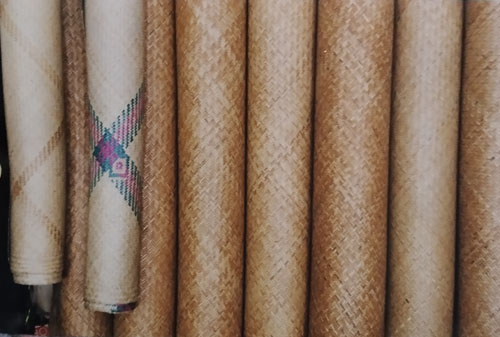Mat-weaving as an art form is traced back to ancient times in India, with sages traditionally being depicted as meditating seated on woven mats, as indicated by an old Bengali proverb, as well as by texts in the Vedic corpus of religious texts. The craft – both mat-weaving and basketry – is described by Kamladevi Chatopadhyaya as ‘interlacing’ two or more strands of the material (reeds, leaves, rushes, cane, bamboo, palm leaves) in different ways, a description that bespeaks an inherent simplicity, but still hints at the poetry of weaving mats and baskets from strips of reeds and leaves.
The craft of mat-weaving is basically a utilitarian rural tradition to create items of everyday use from the raw materials available in profuse quantities in the sub-tropical marshy and wet regions of West Bengal. Mats for sitting on and sleeping on, baskets for carrying and storage, and hand-fans for helping endure the heat are a few of the common products that are made. Different kinds of mats and baskets are made in different areas of West Bengal, depending on the particular reed or grass that is easily available, the weaving traditions specific to an area, and the needs of the local populace.
Well-known (perhaps the most well-known) among the various mats from West Bengal is the sitalpati mat, made from green cane slips of the Maranta dichotoma which are split into very fine slices length wise. This mat is another exposition of the skill of ‘joining grass with grass and interlacing leaves’ to weave an item that is comfortable, utilitarian and beautiful. The quality of the sitalpati mat is judged by its glossiness, smoothness and fineness of texture. It is said that the best kind of sitalpati is so smooth that even a snake cannot glide over it. The word sital or sheetal means cool and the sitalpati mat is famous for the feeling of cool it imparts to the person sitting or sleeping on it. This particular quality of the sitalpati is particularly apt for the warm and humid climate of West Bengal. Mats in general – and sitalpati mats in particular – although defined primarily as a rural craft, linked intimately with everyday life are, however, now available outside of the hinterlands of West Bengal; the aesthetic appeal and utilitarian value of these mats have made them increasingly visible in large towns and metropolitan cities, that is, outside of their traditional market.
The sitalpati mat is made in the northern Cooch Behar district of West Bengal (as well as in the neighbouring states of Tripura and Assam; and in Bangladesh, which was East Bengal in an undivided subcontinent). In West Bengal it is woven dominantly by members of the kayastha caste. (The kayasthas rank below the brahmins but above the mahisyas who weave the popular and less expensive madur mats, with the production concentrated in Midnapore district of East Bengal.) Among the areas in Cooch Behar where sitalpati mats are woven, Sagareswar Ghugumari and Pashnadanga are important centres.
Gallery
YOUR VIEWS
PRACTITIONERS: INDIA
Access 70,000+ practitioners in 2500+ crafts across India.
BIBLIOGRAPHY
10,000+ listings on arts, crafts, design, heritage, culture etc.
GLOSSARY
Rich and often unfamiliar vocabulary of crafts and textiles.
SHOP at India InCH
Needs to be written.






